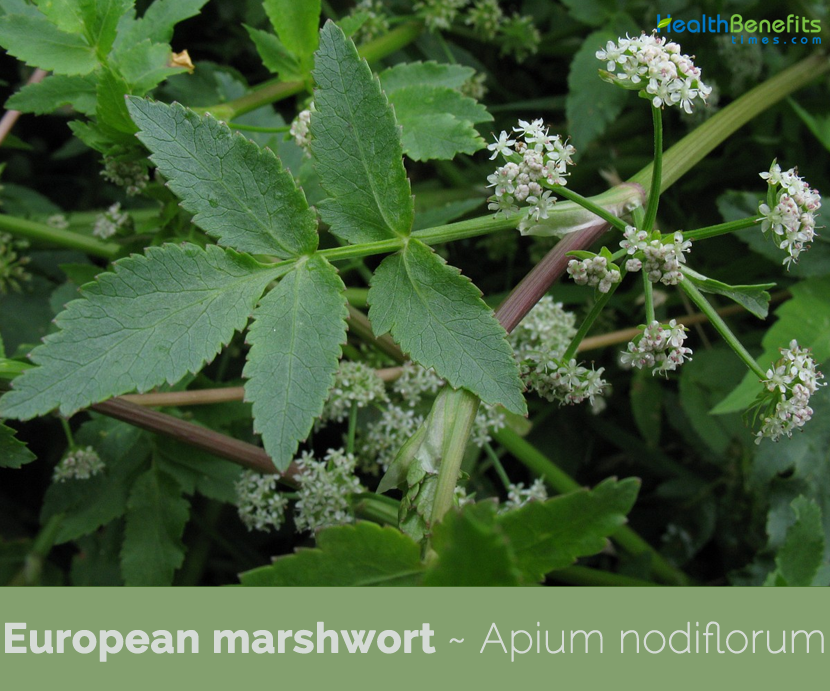Plant Description
European Marshwort is actually a low-growing or prostrate perennial, flowering plant that grows about 30 cm to 1 meter tall. The plant is found growing in wetland habitats such as the margins of rivers, streams, lakes, ponds, canals and ditches as well as in marshy grassland and anthropogenic habitats such as gravel pits. The plant prefers nutrient-rich, neutral soils as well as margins of the river, lakes and ponds. The plant has prostrate and ascending stems. They are smooth, round, hollow and finely furrowed. Leaves are glossy; bright green about 70 cm long with 2 to 8 pairs of toothed stalk less oval to lance-shaped leaflets. Individual flowers are small (2 to 2 mm) with five white petals, and occur in short stalked clusters/umbels (2 to 4 cm) in diameter. Flowering takes place from July and August. Flowers are followed by fruit that are dark brown, small about 2 mm long and ovoid/egg shaped and ribbed.
History
This species has perhaps been consumed since antiquity, though it is difficult to find any clear references to it. For instance, some of the ancient mentions of the celery, a closely related species might be attributed to A. nodiflorum. This could be the case of some references found in Theophrastus or Dioscorides. In the sixteenth-century Spanish translation of the later work, Laguna, in the chapter of the watercress, describes another similar species supposed to be toxic and with the Castilian name of berrazas, the same registered in the recent ethno botanical works.
no images were found
Traditional uses and benefits of European Marshwort- Its tender aerial parts are considered digestive, intestinal anti-inflammatory, depurative, and employed to treat respiratory and urinary diseases.
- Other supposed health benefits of A. nodiflorum include liver protection and bile production.
- Decoction of the whole plant was topically employed to treat eczema in southern Spain.
Culinary Uses
- This species has been traditionally consumed in the Mediterranean countries, at least in Portugal, Spain.
- As other wild vegetables that grow in aquatic environments, A. nodiflorum is mainly consumed raw without any preparation or in green salads.
- It is also cooked in different recipes, such as boiled with legumes, in omelets, as a turnover filling, as a dough stuffing, or included in the Moroccan beqoul, a mixture of several wild food plants used to prepare a springtime meatless dish—highly prized by rural people, especially in mountainous areas.
- The fool’s watercress is also employed as a condiment to aromatize soups or other stews.
- It can also be used to enhance the flour of spinach or other wilted greens.
References:
https://www.itis.gov/servlet/SingleRpt/SingleRpt?search_topic=TSN&search_value=29593#null
http://www.floracatalana.net/apium-nodiflorum-l-lag-
https://plants.usda.gov/core/profile?symbol=apno
http://www.theplantlist.org/tpl1.1/record/kew-2644101
https://www.iucnredlist.org/species/164030/13575513
https://en.wikipedia.org/wiki/Apium_nodiflorum
http://www.nzpcn.org.nz/flora_details.aspx?ID=2444
Comments
| European Marshwort Quick Facts | |
|---|---|
| Name: | European Marshwort |
| Scientific Name: | Apium nodiflorum (L.) Lag |
| Origin | Western Europe and is found throughout the North Island and the north and west of the South Island of New Zealand |
| Colors | Dark brown |
| Shapes | Small (2 mm long) and ovoid/egg shaped and ribbed |
| Taste | Carrot |
| Major nutrients | Vitamin B9 (31.25%) Iron (22.50%) Vitamin E (17.27%) Sodium (16.27%) Calcium (15.20%) |
| Name | European Marshwort |
|---|---|
| Scientific Name | Apium nodiflorum (L.) Lag |
| Native | Western Europe and is found throughout the North Island and the north and west of the South Island of New Zealand |
| Common Names | European marshwort, Fool’s-water-cress, Wild celery, Procumbent Marshwort, Lebanese Cress, Poor Man’s Watercress |
| Name in Other Languages | Catalan: Api bord, Api d’aigua, Api de síquia, Creixen bord, Creixen de bou, Créixens, Créixens bords, Galassa Dutch: Groot moerasscherm English: European marshwort, Fool’s-water-cress, Wild celery, Procumbent Marshwort, Lebanese Cress, Poor Man’s Watercress French: Ache faux-cresson, Ache Nodiflore, Céleri à fleurs nodales German: Knotenblütiger Scheiberich, Knotenblütiger Sellerie Hebrew: כרפס הביצות Irish: Gunna uisce Italian: Sedano d’acqua Maltese: Karfus tal-ilma Polish: Selery wezlobaldachowe Spanish: Apio bastardo, Berraza, Berrera, Berrios Welsh: Dyfrforonen swp-flodeuog, Dyfrforonen Sypflodeuog Western Frysian: Grut feanskerm |
| Plant Growth Habit | Low-growing or prostrate perennial, flowering plant |
| Growing Climates | Wetland habitats such as the margins of rivers, streams, lakes, ponds, canals and ditches as well as in marshy grassland and anthropogenic habitats such as gravel pits |
| Soil | Prefers a nutrient-rich, neutral soils as well as margins of the river, lakes and ponds |
| Plant Size | About 30 cm to 1 meter tall |
| Stem | Prostrate and ascending stems. They are smooth, round, hollow, finely furrowed |
| Leaf | Glossy, bright green to 70 cm long with 2 to 8 pairs of toothed stalk less oval to lance-shaped leaflets |
| Flowering season | July and August |
| Flower | Individual flowers are small (2 to 2 mm) with five white petals, and occur in short stalked clusters/umbels (2 to 4 cm) in diameter |
| Fruit Shape & Size | Small (2mm long) and ovoid/egg shaped and ribbed |
| Fruit Color | Dark brown |
| Flavor/Aroma | Strongly of carrot |
| Taste | Carrot |
| Major Nutrition | Vitamin B9 (Folate) (125 µg) (31.25%) Iron, Fe 1.8 mg (22.50%) Vitamin E (alpha-tocopherol) (2.59 mg) (17.27%) Sodium, Na (244 mg) (16.27%) Calcium, Ca (152 mg) (15.20%) Manganese, Mn (0.29 mg) (12.61%) Vitamin C (Ascorbic acid) 9.11 mg (10.12%) Copper, Cu (0.08 mg) (8.89%) Total dietary Fiber (2.7 g) (7.11%) Magnesium, Mg (28 mg) (6.67%) |
| Precautions |
|
| Other facts |
|



